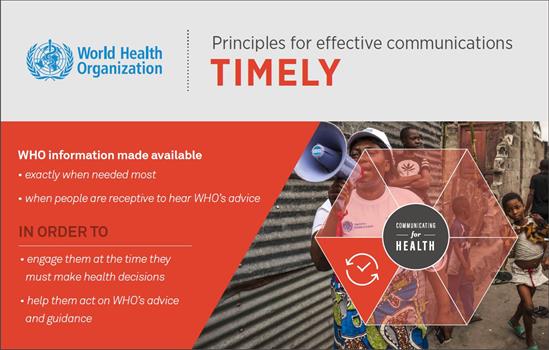
Principle: Timely
Communicate early
Tactics to apply to make your communications timely
Communicate what WHO knows early
WHO communicators work at a fast pace to ensure that urgent health information reaches decision-makers in time to protect health. This information must be accurate to maintain the Organization’s reputation and credibility. The need to be quick and accurate is an ongoing tension in communicating urgently needed health information. WHO cannot sacrifice accuracy, but can still rapidly communicate details it does know, and also explain what the Organization is doing to find answers to areas of uncertainty.
Use social media
Twitter and other platforms can help WHO messages quickly reach millions of people.
- A Twitter-first approach speeds dissemination of critical information that is verified, while more detailed information is developed and cleared.
- WHO Twitter alerts can be sent from the WHO account as SMS messages that can rapidly inform people about urgent health risks. SMS is especially useful to reach target audiences who are in areas where internet connections are unstable.
Engage the media
WHO communicators regularly reach out to local, national and international print, television and radio outlets. There are various approaches for communicators to engage with the media.
Enhance emergency communications
Health emergencies demand rapid dissemination of information and guidance.
If announcements are delayed, people may:
- overreact to the health risk;
- fill the information void with rumours and misperceptions;
- conclude that WHO is unaware of the situation or hiding information, causing audiences to lose trust in the Organization; and
- look elsewhere for information that may be inaccurate or incomplete.
WHO guidelines and planning documents, including the Outbreak Communication Planning Guide, provide ways to enhance emergency communications. Communicators establish WHO as a key source of credible information during an emergency by focusing on these areas of their role.
Quickly release known information about:
- symptoms
- the severity of the threat
- where the threat is located or spreading
- who is at risk
- how people can protect themselves
- what is being done to contain the threat
- how to get answers for additional questions.
Reassure people that they have all the available information, and they will receive more as it becomes known.
Develop precleared documents and templates to expedite the message clearance process.
Respond to media requests 24 hours a day, seven days a week by taking advantage of the different time zones covered by DCO and the regional offices.
Deploy communicators from the Emergency Communications Network to provide additional support, if needed.
Leverage partners
Communicators can work with partners to reach the target audience rapidly by using partners’ familiarity with decision-makers and customized channels to reach them. This should take place on partners’ communications channels and in accordance
with their approval timelines. Communicators keep an up-to-date list of communication contacts from partner organizations and other health agencies to speed coordination of messages and materials.
Principles for effective communications
What we do







